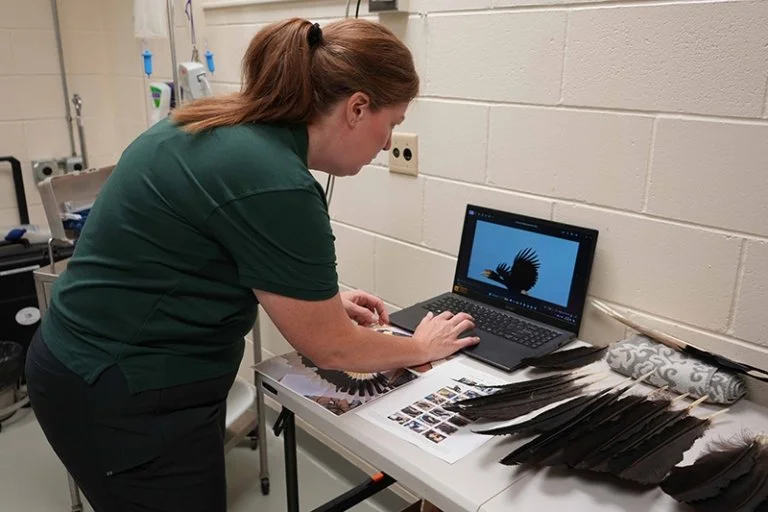Helping a Hornbill Chick Take Flight
On your next visit to the Zoo’s Tropics Trail, turn your eyes to the sky for a colorful new resident. A young rhinoceros hornbill has taken flight! But this chick needed a helping hand before he could spread his wings.
In May 2024, a breeding pair of rhinoceros hornbills hatched a chick. But when it was time to leave the nest, the chick was unable to fly. Upon investigation, Zookeeper Christine Burns discovered the chick’s feathers were underdeveloped and his flight feathers were damaged. Without immediate attention, he would never to learn to fly.
Donor feathers are placed on the rhinoceros hornbill chick to enable him to learn to fly.
The animal care team acted quickly, calling a wide network of experts to help as the Zoo embarked on a procedure called feather imping, which replaces damaged flight feathers with donated, molted (naturally shed) feathers from adult birds.
In total, five institutions, including the Minnesota Zoo, came together to collaborate. The Nashville Zoo and Virginia Zoo donated molted feathers. Expert technicians from the University of Minnesota Raptor Center swooped in to perform the imping procedure, and museum curators from the Bell Museum in St. Paul sent reference photos from a Great Indian Hornbill whose remains were transferred to their collection a few years after the bird lived out his life at the Zoo.
Corryn Vitek, Senior Veterinary Technician with the Raptor Center, reviews imagery of hornbill wing pattern during a feather imping procedure at the Minnesota Zoo in September 2024.
The procedure was an immediate success. Just hours after the imping, the chick was able to make short flights. In early November, the Hornbill family moved to their permanent home on the Zoo’s Tropics Trail, where the chick continues to grow and refine his flying abilities.
This successful collaboration highlights the importance of teamwork and innovation in animal care. The Rhinoceros Hornbill, listed as Vulnerable by the International Union for Conservation of Nature (IUCN), is threatened by habitat loss, hunting, and the illegal pet trade. To support hornbill populations, the Minnesota Zoo participates in the Rhinoceros Hornbill Species Survival Plan (SSP) which includes work such as breeding and hatching of chicks like this one, and the AZA SAFE (Saving Animals From Extinction) Asian Hornbill initiative which helps fund conservation efforts in the wild.
Dr. Anne Rivas DVM, Jamie Toste, and Christine Burns with the rhinoceros hornbill chick following his feather imping procedure.
Efforts like these would not be possible without our donors. Your generosity enables the Zoo to conduct groundbreaking care and innovative treatments that make a real difference for vulnerable species like the Rhinoceros Hornbill both at the Zoo and in the wild. Thank you!



